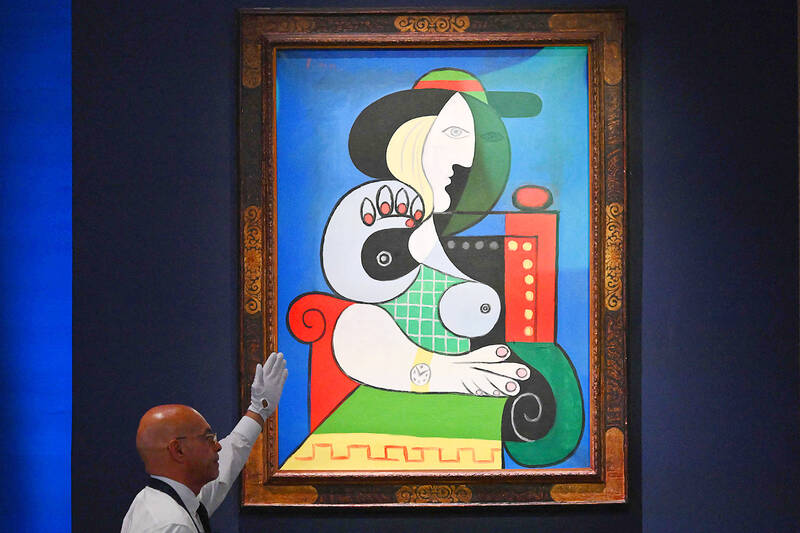Pablo Picasso’s 1932 painting Femme a la montre on Wednesday sold for more than US$139 million at a Sotheby’s New York auction, making it the most valuable work of art sold globally at an auction this year.
The work is a standout of New York City’s fall art auction season, seen by many as a bellwether for the art market. It went under the gavel as part of an estimated US$400 million sale of the collection of late philanthropist Emily Fisher Landau.
The nine-digit price made it the second most-expensive Picasso painting to sell at an auction, behind Les femmes d’Alger (Version ‘O’), which fetched US$179.3 million, including a buyer’s premium, at Christie’s in 2015.

Photo: AFP
Femme a la montre, which translates from French to “Woman with a Watch,” is a portrait of the artist’s lover Marie-Therese Walter seated in a throne-like chair against a blue background. The titular wristwatch is a motif also seen in artwork Picasso made of his wife, Russian-Ukrainian ballerina Olga Khokhlova.
Walter was 17 years old when she met the 45-year-old Picasso in Paris, and the two later entered into a secret relationship while he was still married to Khokhlova. Walter became his subject for a number of artworks, including the 1932 painting Femme nue couchee, which sold for US$67.5 million at an auction last year.
Picasso painted Femme a la montre at a pivotal year in his career. At 50 years old, he had already achieved widespread fame by 1932, but ramped up his ambitions to silence critics who questioned “whether he was an artist of the past rather than the future,” the Tate Modern museum said.
Fisher Landau bought the painting from New York’s Pace Gallery in 1968 and kept it above the mantle in her Manhattan apartment, according to Sotheby’s.
An anonymous buyer beat out two other bidders for the painting.

‘UNUSUAL EVENT’: The Australian defense minister said that the Chinese navy task group was entitled to be where it was, but Australia would be watching it closely The Australian and New Zealand militaries were monitoring three Chinese warships moving unusually far south along Australia’s east coast on an unknown mission, officials said yesterday. The Australian government a week ago said that the warships had traveled through Southeast Asia and the Coral Sea, and were approaching northeast Australia. Australian Minister for Defence Richard Marles yesterday said that the Chinese ships — the Hengyang naval frigate, the Zunyi cruiser and the Weishanhu replenishment vessel — were “off the east coast of Australia.” Defense officials did not respond to a request for comment on a Financial Times report that the task group from

Chinese authorities said they began live-fire exercises in the Gulf of Tonkin on Monday, only days after Vietnam announced a new line marking what it considers its territory in the body of water between the nations. The Chinese Maritime Safety Administration said the exercises would be focused on the Beibu Gulf area, closer to the Chinese side of the Gulf of Tonkin, and would run until tomorrow evening. It gave no further details, but the drills follow an announcement last week by Vietnam establishing a baseline used to calculate the width of its territorial waters in the Gulf of Tonkin. State-run Vietnam News

DEFENSE UPHEAVAL: Trump was also to remove the first woman to lead a military service, as well as the judge advocates general for the army, navy and air force US President Donald Trump on Friday fired the chairman of the Joint Chiefs of Staff, Air Force General C.Q. Brown, and pushed out five other admirals and generals in an unprecedented shake-up of US military leadership. Trump wrote in a post on Truth Social that he would nominate former lieutenant general Dan “Razin” Caine to succeed Brown, breaking with tradition by pulling someone out of retirement for the first time to become the top military officer. The president would also replace the head of the US Navy, a position held by Admiral Lisa Franchetti, the first woman to lead a military service,

Four decades after they were forced apart, US-raised Adamary Garcia and her birth mother on Saturday fell into each other’s arms at the airport in Santiago, Chile. Without speaking, they embraced tearfully: A rare reunification for one the thousands of Chileans taken from their mothers as babies and given up for adoption abroad. “The worst is over,” Edita Bizama, 64, said as she beheld her daughter for the first time since her birth 41 years ago. Garcia had flown to Santiago with four other women born in Chile and adopted in the US. Reports have estimated there were 20,000 such cases from 1950 to